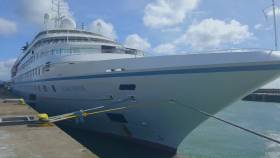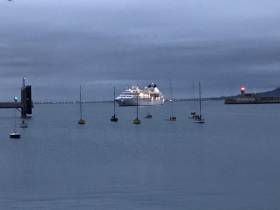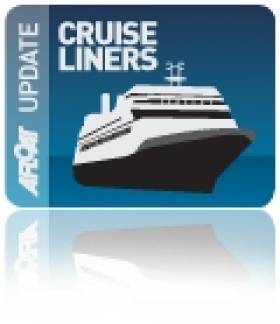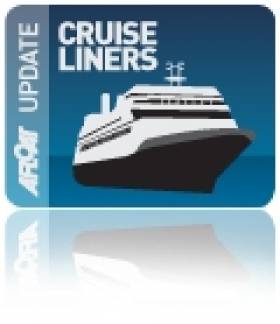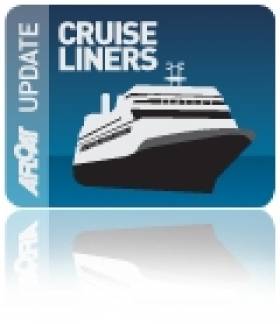Displaying items by tag: Windstar Cruises
Small Luxury Cruiseship Calls to Dun Laoghaire Harbour In Advance of Enlargement & Renovation
Cruiseships visiting Dun Laoghaire Harbour have reached beyond the half-way mark this season as the fourth of six scheduled callers berthed this morning, writes Jehan Ashmore.
Windstar Cruises Star Pride arrived to the south Dublin Bay port having made an overnight passage from Dunmore East, Co. Waterford. This involved an anchorage call off the south-east fishing harbour though the Port of Waterford recieves callers that includes the city.
Cruisegoers of up to 208 passengers on board the small all-suite luxury cruiseship which has a crew of 164 is to remain in Dun Laoghaire up to 18.00hrs when a cruise departs from Carlisle Pier. The 8-day Gaelic Explorers cruise is to take guests to locations among them Isle of Man, Portrush (for the Giant's Causeway), the west coast of Scotland, Invergordan and finally Edinburgh (Leith).
Currently the operator's online brochure fare for the cruise of $7399 has been reduced to $3,499 per person. Guests on the cruise will be pampered in 106 suites, including two deluxe Owners' Suites, four Classic Suites, and 100 Balcony and Ocean View suites.
Windstar Cruises fleet asides conventional tonnage has sail-assisted cruiseships including Windsurf, the most frequent caller to Dun Laoghaire Harbour since the cruise sector business was targeted with concerted efforts in 2011. Since then the US operator has been a regular caller and recently they won the Best Small Ship Cruise Line for the Second Year in a Row in the 2019 TravelAge West Wave Awards.
A clear indicator in business confidence by Windstar is the investment in a $250m 'Star Plus' initiative. According to the cruise company this will be the most complex and comprehensive small ship lengthening, engine replacement, and renovation project undertaken in cruising.
The Star Plus project will see Windstar take half of its entire fleet to be renovated in succession starting with Star Breeze, Star Legend, and finally Star Pride.
In April this year, work began on the first steel cutting in preparation for the first ship to undergo the renovation at Fincantieri’s Arsenale Triestino San Marco shipyard in Trieste, Italy. The first of the cruiseship trio to recieve work will be Star Breeze in October 2019 and this is scheduled to end with the departure of Star Pride from the yard in November 2020.
In the public areas renovation is to include two new dining venues, a spa, infinity pool and fitness area. The luxury ships will also boast new bathrooms in every suite and a new category of Star suites, featuring a new layout. The suites with ocean-views will have 277 square feet of comfort.
These small yet popular ships will be cut in half to allow the installation of a new stepped mid-body section that will lengthen each vessel by approximately 25 meters.
The total capacity of these expanded ships will be increased to 312 guests.
In order to reflect the enlarged cruiseship trio, additional crew will be hired in order to maintain the luxury operator's impressive 1.5 to 1 guest-to-service staff ratio.
Star Breezes In With Return to Ferryports Past And Present
#Cruiseliners - Star Breeze concluded the cruise season to the former ferryport of Dun Laoghaire Harbour last weekend, having already made a second call earlier this month, writes Jehan Ashmore.
Star Breeze arrived on 15 September following an overnight passage from Belfast Harbour, where the port is only served by a single operator, Stena Line, but serving to three ports. These ports involve two in England, Heysham and Birkenhead (Liverpool) and the third port located in Scotland is at Cairnryan.
As previously reported on Afloat.ie, this year Dun Laoghaire Harbour's cruise season was only to consist of three callers with the arrival of Star Breeze comfirming the completion of scheduled calls. The other visitor was made up by sister Star Pride that in June launched the season. Compared to the 2017 season that saw 8 callers arrive in the attractive harbour.
The pair of mega-yacht boutique cruiseships operated by US based Windstar Cruises, serve at the higher-end of the market. In addition there is a third sister, Star Legend which too made a visit to the south Dublin Bay harbour during last year's busier season.
This season also marked another year without a considerably larger cruiseship at anchorage offshore. So no tenders were to be seen back and forth to the Carlisle Pier which lies adjacent to the East Pier, a place particularly popular for its public amentity values as it juts out into Dublin Bay.
As for the Star Breeze which pampers up to 212 guests in luxurious facilities among them in lounges, a club-bar, casino, screening room, computer room and a library. Leisure facilities include a spa, two whirlpools, a swimming pool and a fitness centre. Accommodation comprises suites and located on the outside to take advantage of ocean views and ports of call.
On this most port recent call to Dun Laoghaire, Afloat noted the Star Breeze did not take the customary cruise-berth at Carlisle Pier. According to Dun Laoghaire Harbour Company, Star Breeze was making a transit port of call as distinct to a turnaround call. This would otherwise take place along Carlisle Pier, where there is more spacious surroundings and easier direct access for coaches making quayside arrivals and departures.
In addition at Carlisle Pier also known to older generations as the 'mail-boat' pier (for Holyhead) the pier was in use to accommodate the Laser Masters World Championships. Instead, Star Breeze was allocated a berth at St. Michaels Pier located more centrally on the harbour's waterfront.
The two-berth facility was custom built in the 1960's to handle the ferry service to north Wales. Use of this new terminal did not entirely replace Carlisle Pier until it was finally made redundant with the introduction of the revolutionary Stena HSS (Highspeed Sea-Service) craft Stena Explorer in 1996.
The car, coach and HGV vehicle capable carrying catamaran HSS Stena Explorer served the Holyhead route for almost two decades. The HSS used a specialist custom built docking system in addition Dun Laoghaire Harbour was given a purpose built terminal replacing an ageing structure from the original terminal.
Since the closure of the Irish Sea route which took place with Stena Explorer making a final crossing just over four years ago, on 14 September 2014, the harbour's sole anchor tenant was lost to neighbouring Dublin Port.
The capital's port is where however Stena Line had already in existance operations to Holyhead that began in 1995 with the launch of a freight-service with limited passenger capacity. The Dublin route is currently maintained by Stena Adventurer and Stena Superfast X. This ship replaced a smaller fleetmate, Stena Nordica, in part to compensate for the withdrawn HSS Stena Explorer.
It is from Dun Laoghaire Harbour's St. Michaels Pier's terminal where the HSS exclusively served from its speciliast berth, but the purpose of its terminal is now to change by housing the Harbour Innovation Campus. A fit-out of new office space is due to be completed this winter in readiness for these new businesses to occupy this prime location in the harbour.
Further changes are underway, see recent story on the harbour's transfer which follows 'common concerns' by stakeholders on the future roles? of the harbour. As back in 2011, there were plans for a regenerated harbour with new facities, notably plans for a cruise berth jetty, an urban beach and a 'flotel'.
Since Stena officially announced in early 2015 not to continue HSS service to Holyhead, the terminal became occupied for several years with the Shackleton Endurance Exhibition. This was to highlight the achievements of Irish born Sir Ernest Shackleton, who led the four-year long Imperial Trans-Antarctic polar expedition that concluded more than a century ago in 1917.
The exhibition located in the terminal's front entrance was subsequently used as an art space which included works by the renowned historian and artist, Peter Pearson whose paintings focused on Dun Laoghaire's maritime history. Scenes depicted the Holyhead 'mail-boats' and replacment conventional roll-on roll-off car ferries.
Among these car ferries was Sealink/British Rails St. Columba, that would become part of Sealink British Ferries and ultimately into the realm of Stena Line.
The Danish custom-built ferry dating to 1977 served the Dun Laoghaire-Holyhead route loyaly until replaced by the Stena HSS in 1996. However in that timeframe, the ferry was renamed Stena Hibernia while a fleetmate, St. Anselm dating from 1981 was renamed Stena Cambria and served in the early to mid 1990's. The renamings were a homage to the last mail-boats, the sisters Hibernia and Cambria, representing the Welsh counterpart. It is somewhat full circle, as Stena Hibernia was renamed again as Stena Adventurer, the same name given to one of the two ships currently operating the Dublin-Holyhead service as previously mentioned.
The mail-boats, car ferries and the Stena HSS, each represent historic chapters that make up Dun Laoghaire Harbour's rich maritime heritage and follows the bicentenary celebrations of 2017.
The year 2018 will be remembered as a particularly quiet year in terms of cruiseships, however Afloat awaits with keen interest as to what the harbour beckons for the 2019 cruise season.
Windstar Brings A Breeze to Dun Laoghaire Harbour
#CruiseLiners - A Windstar Cruises boutique style luxury ship docked in Dun Laoghaire Harbour yesterday, though only as the second of just three callers due this season, writes Jehan Ashmore.
Star Breeze operating with a mere 212 guest capacity had sailed from Douglas, Isle of Man to Dun Laoghaire Harbour with arrival around dawn. The call of the almost 10,000 tonnes ship marked the first since the season opened back in June when a sister Star Pride docked within the south Dublin Bay port.
The Bahamas flagged Star Breeze remained in port for around 11 hours so visitors could explore Dun Laoghaire-Rathdown and the neighbouring region.
On previous seasons, the number of callers to Dun Loaghaire exceeded double figures, notably including considerably larger capacity cruiseships that had to anchor offshore. The 14,000 tonnes sail-assisted Wind Surf, also operated by the US based Windstar, was until last season the most frequent caller which involved berthing along Carlisle Pier, the harbour's only dedicated cruise-berth.
The final caller to Dun Laoghaire Harbour this season will be Star Breeze which is to repeat a call taking place also this month, on 15 September. On this occasion, the duration of the visit is to be extended to 16 hours, permitting a night-time departure.
This concluding call will also mark a season for Dun Laoghaire Harbour Company that has depended on just one operator, albeit operating at the high-end of the luxury cruise market.
Dublin Port Cruise Calls To Increase in 2017 While Dun Laoghaire Remains With Last Year's Total
#CruiseIncrease – Dublin Port in 2017 is to welcome a total of 125 cruise calls an increase on last year, however Dun Laoghaire Harbour will have a repeat of last year with eight calls, writes Jehan Ashmore.
As previously reported on Afloat, Fred Olsen’s Boudicca became the first caller of the New Year and follows last year's total of 112 calls. Of these calls for season 2017 the most regular caller scheduled will be Princess Cruises 3,142 passenger 'Grand' class giant, Caribbean Princess.
The 112,894 gross tonnage ship hit the headlines for all the wrong reasons last year due to a power-failure and use of a 'magic polluting pipe'.
At Dun Laoghaire Harbour is where a handful of calls totalling eight cruiseships called in 2016. This is to be repeated with another welcome this year to the south Dublin Bay harbour. On previous seasons the total has been around a dozen calls.
The majority of callers been from operator Windstar Cruises. Once again their impressive five-mast sail assisted Wind Surf, the most frequent caller since the trade to the harbour was revived in 2011 is to make two visits in 2017. In addition to fleetmates but of conventional tonnage.
Afloat has examined the cruiseship list season 2017 and notably there will be no giant cruiseships making anchorage calls off Dun Laoghaire Harbour. This is due to smaller sized cruiseships and therefore they will be accommodated within the harbour alongside Carlisle Pier.
This year Dun Laoghaire Harbour can look forward to celebrating a significant milestone as it is the 200th anniversary of the beginning of its construction in 1817. This was to provide a port of 'refuge' with a single pier as originally planned. This pier ultimately became the East Pier, following the completion of this feat of marine engineering in 1842 with the building of the West Pier to form the ‘asylum’ harbour.
Cruiseship-Yacht Makes Return Visit to Dun Laoghaire Harbour
#CruiseYacht- Cruiseship-yacht Wind Surf (14,000 tonnes) with her impressive five 164-ft masts docked today in Dun Laoghaire Harbour and during the port's third cruise season, writes Jehan Ashmore.
The flagship of Windstar Cruises five-strong fleet as reported yesterday has a capacity for 310 guests and towering above her passenger decks are the masts that set seven triangular shaped computer controlled self-furling sails that total 26,000 sq m.
She sailed overnight from an anchorage call off Dunmore East and her visit to Dun Laoghaire Harbour is a fly-cruise turnaround, likewise to her two previous calls last year.
On that final visit last July during the 'heatwave', as she departed her sails were furled -out (click link for photo) which was an added bonus to those strolling the harbour piers.
Wind Surf relies mostly on engine power (hence the funnel between the second and third masts), has four Wartsila diesel-electric generating sets and a pair of electrical propulsion motors that deliver 12 knots. This can be increased by combining her sails to achieve 15 knots with a favourable wind. During joint-power operations she has a sea-water hydraulic ballast system to limit heel when sailing.
As to be expected the 187m flagship has luxurious amenities and a crew of almost 200 on board the vessel that was launched as Club Med 1 a quarter-century ago for original owners Club Med. She was last extensively renovated in 2012. Her sister was in Irish waters this week when Club Med 2 called to Cobh.
Both vessels throughout their careers have cruised mostly in the Mediterranean and Caribbean, however last year was a first for operators Wind Star and Club Med to visit Irish ports. This evening she may or not 'self-furl' her sails, but will certainly motor out of the harbour bound for Douglas, Isle of Man.
#windsurf – The five-mast Wind Surf cruise yacht will dock at Dun Laoghaire Harbour at 7am on Saturday, 12th July. It will remain docked at the south Dubllin Bay port until 6.30pm when it will depart to the Isle of Man. It also visited Dublin Bay on Wednesday emerging from Dublin Port under sail.
The Wind Surf is the largest ship in the Windstar Cruises fleet and is known for its luxurious amenities carrying 312 guests and 191 international staff. The Wind Surf, one part sailing yacht and one part upscale cruise ship, has seven triangular, self-furling, computer operated sails.
'Wind Surf' arrives in DL pic.twitter.com/B4aa2rv0tv
— Gareth (@garethoconnor) July 12, 2014
Cruiseships Visits to Bring Variety to Waterford Estuary
#WaterfordCrystalCruises – Opening the Port of Waterford's cruise season next Monday is Noble Caledonia's Island Sky, the 118 passenger and 77-crew vessel is to dock along the city's quays, writes Jehan Ashmore.
Island Sky is the first of 17 cruise callers to the 'Crystal' city among them Crystal Cruises six-star rated Crystal Symphony (940 passenger/545 crew) which calls in August and Crystal Serenity (1080/655) to form the final cruise call of the season in early September.
Island Sky will also be the first cruise caller to make a repeat call in June out of the 12 cruiseships visiting, among them the largest Celebrity Infinity (see pictured under cruise-schedule list link). The 3,000 plus passenger vessel and more than 1,200 crew on board are to anchor off Dunmore East and like last year she is to return this season in June and August respectively.
Also due to make an impressive sight off Dunmore East in July and September, is Wind Surf, the 310-guest vessel, which as the name suggests sets seven triangular self-furling sails than are operated by computers. The former Club Med I currently operated by Windstar Cruises has a sail surface area of 26,881sq ft set on five 164-ft masts.
The third location in Waterford Estuary for cruise callers is the port's main terminal at Belview Port which as previously reported on Afloat.ie is connected with an inter-model operation with freight-train services linking in with regular containership calls.
However in August, the cruise season's only caller to dock along Belview is to be Regent Seven Sea Cruises Seven Seas Voyager, another six-star rated vessel with capacity for 700 guests and pampered by almost 500 crew.
#TallCruiseships – Anchored less than a nautical mile offshore of Portrush today is the impressive Wind Surf, which has five 50m/164ft high masts towering above the sea, writes Jehan Ashmore.
The Windstar Cruises vessel with a 312 guest capacity is calling to the small Antrim harbour by tender craft to see the main visitor attraction of the Giant's Causeway.
The call of the Bahamas flagged cruiseship to the north is part of a 7-day Gaelic Explorers cruise with visits to Peterhead, Invergordon, Kirkwall, Portree and Isle of Man.
Cruise highlights include Edinburgh Castle, where the cruiseship departed from nearby Leith followed by a call to Orkney to sample the customary famous whiskey distilleries, and the 5,000-year-old Ring of Brodgar, rivaling England's Stonehenge.
Wind Surf is to return to Dun Laoghaire Harbour this Saturday, having made her maiden port of call to the harbour in July.
On that occasion the call involved a 'turnaround' cruise while berthing alongside the Carlisle Pier, which provides easy observation from the East Pier.
The French built 14,745 tonnes vessel launched as Club Med 1 and she has a self-unfurling computer-operated system from the masts that controls seven triangular sails totalling 2,600sq.m/26,881sq.feet
She has a length of 162m /535ft at waterline though if measured to include the bowsprit the overall dimension increases to 187m/617 feet.
Meanwhile, today her sister Club Med 2 docked in Cork's Ringaskiddy Terminal having sailed overnight from Dublin Port (see first visit), where the capital first welcomed the vessel earlier in the season.
Another cruiseship fitted with sailing masts, Sea Cloud II had also toured Irish ports with calls to Dublin, Cork as well as Belfast.
Gathering Cruise Flotilla and Five-Masted Cruiseship to Centre on Dun Laoghaire Harbour
#GatheringCRUISES- On the same day of the eagerly awaited Gathering Cruise which sets off next Thursday (18 July) from Dun Laoghaire Harbour, the Wind Surf a 14,745 tonnes cruiseship sporting five masts and each 50m/164 ft-high is due to berth, writes Jehan Ashmore.
Wind Surf has 7 triangular, self-furling, computer-operated sails with 26,881 square feet (or 2,600 square meters) on a Dacron surface area.
The 7-decked vessel has a guest capacity for 310 who are accommodated in 123 de-luxe ocean-view staterooms and a couple of de-luxe suites situated on the bridge deck.
Originally the Wind Surf was launched as Club Med 1 and her sister as previously reported is the Club Med 2 which recently called to Irish ports for the first time to include Dublin Port.
Operators Windstar Cruises are bringing the 1998 built vessel to Irish waters in what is undertood to be also her inaugural visit to Irish waters and this evening the ship departed Portsmouth bound for Dartmouth.
Following her call to the Devon port, the cruise which is a total of 7-nights (with fares starting from around £2,300 sterling per person), is also to visit Falmouth, the Scilly Isles, Milford Haven and Holyhead.
The Co. Waterford coast will in fact be her first Irish port of call where the 162m/535ft vessel is due to anchor off Dunmore East on 16 July. While on the same day the Sea Cloud II, another luxury cruise tallship rigged with three-masts is to call to Dublin Port following her visit to Cork Harbour which is scheduled to call this Saturday.



























